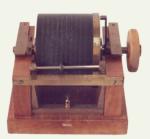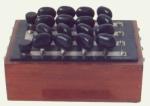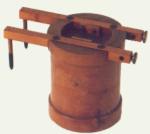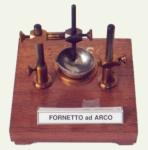

 Menu
Menu
|
Function Variable resistance to be inserted in the circuit. |

| ||
|
|||
|
Description It is a rheostat with a carbon resistance. By rotating the carbon cylinder we change the position where the contact happens between the little metallic wheel and the lateral surface of the cylinder. The surfaces of the basis of the cylinder are each connected to a chuck. The wheel is connected to a third chuck. | |||
|
Function |

| ||
|
|||
|
Function To measure resistances. |

| ||
|
|||
|
Other resistance box University (2), University (3) |
 (1) (1)
| ||
|
Function To have resistances of different quantities. | |||
|
|||
|
Function To measure resistances. |

| ||
|
|||
|
Function To measure the resistance of an electrolyte. |

| ||
|
|||
|
Description It is formed by a glass container placed on a wooden basis. The electrodes are formed by pierced metallic disks. A central hole on the lid is used to insert the thermometer that also goes through the holes of the disk. | |||
|
Function To show the chemical effects of the electric current. |

| ||
|
|||
|
Description It is formed by a V-shaped glass tube grafted vertically on a low column that leans on a wooden circular basis. The electrodes are placed at the end of the tube. | |||
|
Function To show the chemical effects of the electric current. |

| ||
|
|||
|
Description To obtain the electrolysis with this voltameter we pour acidulous water into the tank and then we fill the two little bells with the same liquid. Then, keeping them closed with a finger, we overturn them and we immerse them into the liquid of the tank by hanging them to their respective hooks. Then we connect the electrodes to a 4-6 volt cell. | |||
|
Function To show the transformation of the electric energy into heat. |

| ||
|
|||
|
Description From a wooden rectangular basis rise two little columns. From these two little bars branch off horizontally, one of which supports a carbon electrode while the other supports a little cup. It is an arc-lamp in which one of the carbons has been substituted by the melting-pot. | |||
|
Function To show the functioning of a dry cell. |

| ||
|
|||
|
Description It is formed by many disks of silver or golden paper held by an ebonite bar, and pressed between two terminal armatures. | |||